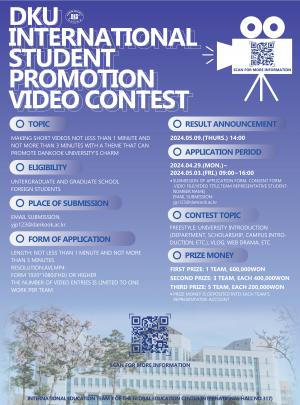If you are interested in Korean culture, you are already familiar with the dinners and drinking sessions depicted in Korean dramas. In shows dealing with the lives of university students, scenes of new and end-of-semester parties are often reflected. Without exception, alcohol plays a prominent role in these dramatic depictions. It makes the atmosphere of the parties more vigorous and energetic, but does this reflect the reality of drinking in Korea? The Dankook Herald (DKH) looked into the relationship of Korean Dankookians (Students of Dankook University) with alcohol.
There is a special saying Koreans use when touching glasses for a toast. We say ‘jjaan’. When said, it feels appropriate as it mimics the sound that is made when glasses touch. Although there are no special forms of etiquette when drinking with peers, if there are the elders present, some general rules apply. When you drink, you must turn your head to the left or right and take it down in one shot, if there is an elder in front of you. Also, it is considered polite to fill the glasses of your elders first, and when you touch their glass, it is better to make contact with the lower part of the their vessel.
Another prominent feature of Korean drinking culture is mixing different types of alcohol in various combinations to often soften the blow of any harsh tastes. The most popular one is ‘Somaek’, which is a mixed cocktail of Soju and Maekju, or beer in Korean. There are various kinds of ‘Somaek’ combinations. ‘Tesla’ is one of them. When hearing this name, many international Dankookians will immediately think of the American electric vehicle and clean energy company run by Elon Musk. However, in Korea, ‘Tesla’ also means a cocktail made of the beer ‘Terra’ and the soju ‘Chamisul’. The name comes from combining the two words. Another combination is ‘Maksa’, a mixture of the Korean traditional alcoholic beverage ‘Makgeolli’, with ‘Sprite’. Since the sweetness of the cider neutralizes the sour taste of makgeolli, those who try it will be able to enjoy a softer version of makgeolli, without any resistance to its unfamiliar taste. The last one is ‘Hallatonic’, a mixed cocktail made up of a Jeju island soju named ‘Hallasan’ and ‘tonic water’. If you have ever been to any Korean bars, you may have seen the name 'Hallatonic' on the menu. It is a good way for international Dankookians to try soju because the tonic water neutralizes the bitter taste of the soju. Trying a Jeju island local soju, which is popular in Korea, would be a great experience for visitors to the country.
As Koreans enjoy drinking, various hangover cures have also been made. Before going out for the night, Koreans take hangover helpers, in pill or drink forms, which are easily found at convenience stores. You can also relieve hangovers by having chocolate milk or pear cider after you drink. Koreans typically love such beverages as a typical after-drinking hangover treatment. Though both chocolate milk and pear cider were never intended to relieve hangovers, all Koreans are familiar with the concept that these beverages help sober you up. If someone asks you "Do you want me to buy you chocolate milk?" in the middle of a drinking session, take it as a sign they are trying to help you out.
 |
| ▲ A popular pear drink to relieve hangovers (Photo from Auction) |
The DKH conducted interviews with Dankookians about their drinking culture. Most students agreed ‘Somaek’ was their beverage of choice. “Usually, it is mixed at a ratio of 8 beer and 2 soju. But the proportion of soju may be further increased depending on the taste of the person making it” said one student. They also recommended ‘Maksa’ and ‘Gojingamrae (a mixture of soju and beer with coke)’. In the case of ‘Gojingamrae’, the recipe is noteworthy. Add a soju glass filled with coke into your beer glass. On top of it, place a shot of soju. Fill the remaining space with beer. The goal is not to sip at it, but rather to drink it all at once. When you pick up the glass, the different liquids are taken in by layers. Originally, ‘Gojingamrae’ was one of the four-character idioms that says, ‘sweet things come after bitter things.’ This way of drinking operates under this concept. As for hangover relief, most students listed pear drinks as the top choice for recovery because it is effective in decomposing the components of alcohol. Other students said drinking as much water as possible and getting a good sleep helps in the recovery process. However, as an ethnicity who loves food with spicy flavors, the most common remedy mentioned was red soups such as ramyeon and malatang.
 |
| ▲ Gojingamrae-ju, a combination of soju, beer, and coke (Photo from Seoul newspaper) |
Korea has many different traditions to enjoy. Among them is our ‘drinking culture’. It is an essential activity for foreign students who want to experience the real vibe of Korea. Winter, the season when lots of meetings with friends are made, is coming. We hope Dankookians get to experience a wise and joyful drinking culture, while of course, complying with government guidelines in the living with Covid-19 area.
최민지, 류시은, 김서연 dankookherald@gmail.com

![[Campus Magnifier] Let's Surf the Library!](/news/photo/202404/12496_1765_4143.jpg) [Campus Magnifier] Let's Surf the Library!
[Campus Magnifier] Let's Surf the Library!
![[Campus Magnifier] Let's Surf the Library!](/news/thumbnail/202404/12496_1765_4143_v150.jpg)





